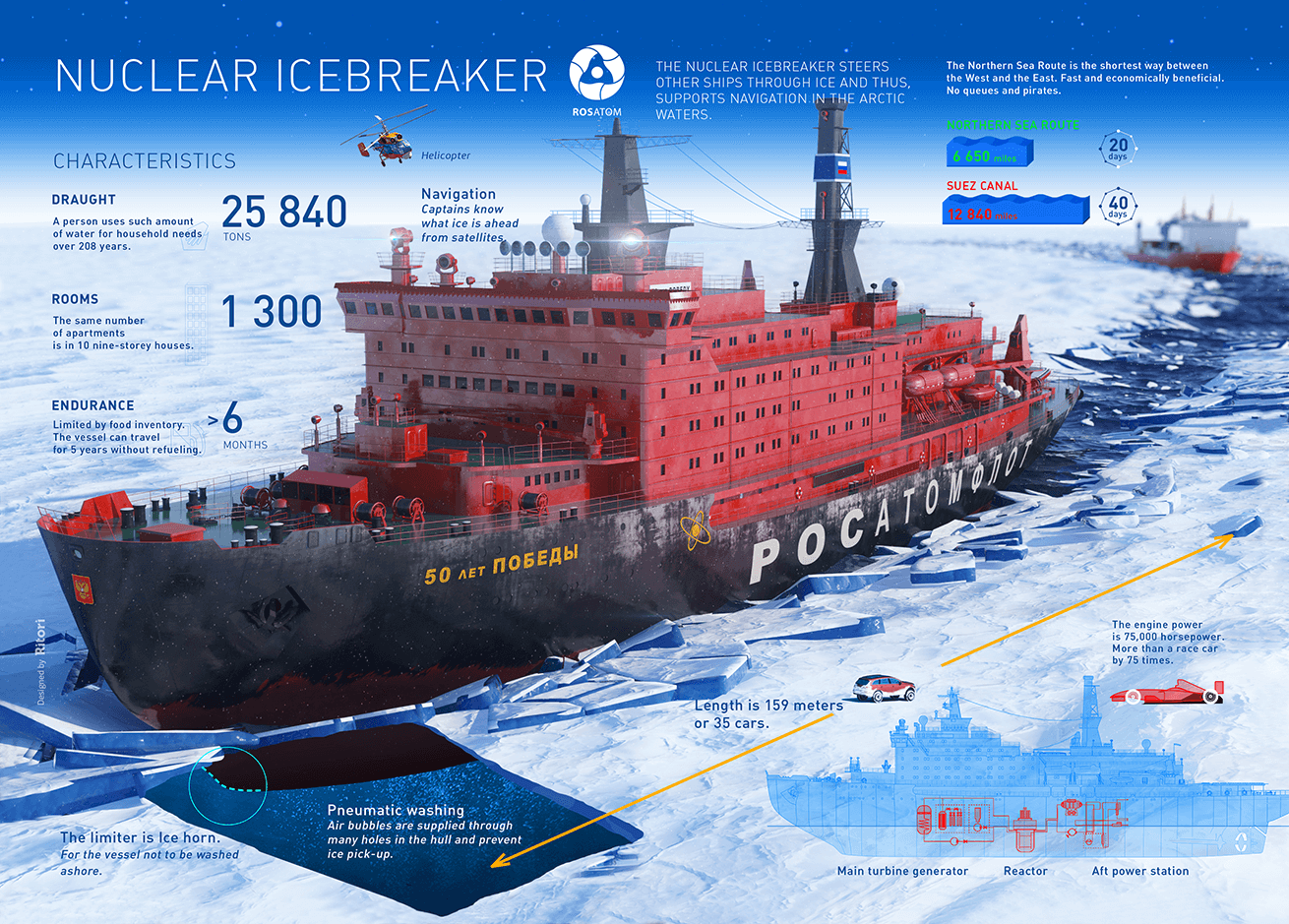Russia has announced that the construction of the world’s most powerful nuclear icebreaker, the “Rossiya,” is expected to be completed by 2030.
First Deputy Prime Minister Denis Manturov made this announcement on May 20 after a meeting with Prime Minister Mikhail Mishustin. Details were shared on the government’s Telegram channel.
Manturov said that the Rossiya was currently under construction at the Zvezda shipyard in the Far East. The vessel would be equipped with two RITM-400 reactor plants, each boasting a capacity of 315 MW.
This state-of-the-art icebreaker will feature impressive specifications, including a speed of 23 knots, a length of 209.2 meters, a width of 47.7 meters, and a depth of 18.7 meters.
Once operational, it will be the most powerful vessel of its kind globally, capable of breaking through ice up to 4.3 meters thick and creating a channel up to 50 meters wide.

Manturov mentioned that the Baltic Shipyard continued building nuclear icebreakers with a capacity of 60 MW. Among the shipyard’s icebreakers were the operational vessels “Arktika,” “Sibir,” and “Ural” in the Arctic Ocean.
The icebreaker “Yakutia” is slated for commissioning by the end of 2024. Manturov highlighted that three additional nuclear-powered icebreakers were set to join the fleet between 2026 and 2030, with the Rossiya marking a significant leap in capability and power.
The Rossiya is the first of three vessels planned under Project 10510, all of which are to be constructed by 2033. These icebreakers will be managed by Atomflot, a subsidiary of Rosatom, which oversees Russia’s fleet of nuclear-powered icebreakers.
The design and technical specifics of these vessels are being developed by the Iceberg Central Design Bureau, ensuring they meet the demanding conditions of the Arctic environment.
In 2021, Russian nuclear engineering firm JSC Afrikantov OKBM began producing key components for the RITM-400 reactor plant. These include the reactor cover, a block of pipes and devices, compensating group drives for the protection control system, an internal shaft, and electric pumps.
The RITM-400 reactor represents a significant evolutionary step from the RITM-200, which is used in current icebreakers under Project 22220, such as the Arktika, which began operations in October 2020.
With a thermal power increase of 315 MW, the RITM-400 is 1.8 times more powerful than its predecessor. This advance will enable the Rossiya and its sister ships to ensure year-round navigation along the Northern Sea Route and support Arctic expeditions, including those involving large-capacity vessels.
Russia’s Large Fleet Of Icebreakers
Russia is the only country currently operating nuclear-powered icebreakers, boasting seven of these vessels. Additional ones are in line for future commissioning. When conventionally powered ships are taken into account, Russia’s fleet of icebreakers increases to approximately 40.
In stark contrast, the United States struggles with a glaring icebreaker deficit, possessing only one fully operational icebreaker and another plagued by reliability issues.
This stark contrast has profound strategic implications, as Russia’s robust icebreaker fleet positions it as the primary steward of Arctic navigation and resource exploitation.
Moscow’s initiatives extend beyond icebreaking capabilities, encompassing the acquisition of missile-armed corvettes designed to penetrate ice-covered waters and the establishment of elaborate Arctic bases for military operations.
Further, Russia’s commitment to bolstering its Arctic presence is exemplified by the modification of a specialized submarine for operations in the region.

However, large nuclear-powered icebreakers, such as the upcoming Rossiya, serve as the linchpin in Russia’s quest to maximize the Arctic’s potential.
In comparison, the United States’ icebreaking capabilities languish, with the US Coast Guard grappling with aging vessels prone to mishaps.
In August 2020, the United States Coast Guard Cutter (USCGC) Healy encountered a fire incident and propulsion system malfunction, compelling it to abort a scheduled mission in the Arctic and head back to base. Likewise, the larger yet older USCGC Polar Star has faced similar severe mishaps in recent times.
While the US Coast Guard is set to receive three new heavy icebreakers, the continuous delays in acquisition programs underscore the uphill battle to close the gap with Russia. These vessels, though similar in size to Russia’s Project 22220s, remain years away from entering service.
Former US President Donald Trump supported the idea of the US government acquiring nuclear-powered icebreakers. In July 2020, he mentioned that efforts were being made to secure additional icebreaking capacity in the future, potentially involving a foreign country. However, there has been no further public discussion about this plan or its details since then.
- Contact the author at ashishmichel(at)gmail.com
- Follow EurAsian Times on Google News




